Towards the Introduction of Sustainable Fishery Products: The Bid of a Major Italian Retailer
Abstract
:1. Introduction
2. Materials and Methods
3. Results
4. Discussion
5. Conclusions
Supplementary Materials
Acknowledgments
Author Contributions
Conflicts of Interest
References
- Cowley, D.; Coulon, J.R. Consumer preferences with regard to local and sustainable seafood. J. Environ. Res. Econ. Colby 2014, 1, 184. [Google Scholar]
- The State of World Fisheries and Aquaculture. Contributing to Food Security and Nutrition for All; FAO: Rome, Italy, 2016; p. 200. [Google Scholar]
- OECD (Organization for Economic Co-operation and Development); FAO (Food and Agriculture Organization of the United Nation). OEDC/FAO Agricultural Outlook 2014–2013; OECD Publishing: Paris, France, 2014. [Google Scholar]
- Bellmann, C.; Tipping, A.; Sumaila, U.R. Global trade in fish and fishery products: An overview. Mar. Policy 2016, 69, 181–188. [Google Scholar] [CrossRef]
- Froese, R.; Zeller, D.; Kleisner, K.; Pauly, D. What catch data tell us about the status of global fisheries. Mar. Biol. 2012, 159, 1283–1292. [Google Scholar] [CrossRef] [Green Version]
- Ward, T.J.; Phillips, B. Anecdotes and lessons of a decade. In Seafood Ecolabelling: Principles and Practice; Ward, T., Phillips, B., Eds.; Wiley-Blackwell: Oxford, UK, 2008; pp. 416–435. [Google Scholar]
- Washington, S.; Ababouch, L. Private Standards and Certification in Fisheries and Aquaculture Current Practice and Emerging Issues; FAO: Rome, Italy, 2011. [Google Scholar]
- Hadjimichael, M.; Hegland, T.J. Really sustainable? Inherent risks of eco-labeling in fisheries. Fish. Res. 2016, 174, 129–135. [Google Scholar] [CrossRef]
- Thøgersen, J.; Haugaard, P.; Olesen, A. Consumer responses to ecolabels. Eur. J. Mark. 2010, 44, 1787–1810. [Google Scholar] [CrossRef]
- Parkes, G.; Young, J.A.; Walmsley, S.F.; Abel, R.; Harman, J.; Horvat, P.; Lem, A.; MacFarlane, A.; Mens, M.; Nolan, C. Behind the signs—A global review of fish sustainability information schemes. Rev. Fish. Sci. 2010, 18, 344–356. [Google Scholar] [CrossRef]
- European Union. Report of Scientific, Technical and Economic Committee for Fisheries (STECF)—Monitoring the Performance of the Common Fisheries Policy (STECF-16-03); Publications Office of the European Union: Luxembourg, 2016; p. 60. [Google Scholar]
- Cataudella, S.; Spagnolo, M. Lo Stato della Pesca e Dell'acquacoltura Nei Mari Italiani; Ministero delle Politiche Agricole Alimentari e Forestali: Rome, Italy, 2011; p. 877. [Google Scholar]
- Scientific, Technical and Economic Committee for Fisheries. Review of Scientific Advice for 2014—Consolidated Advice on Fish Stocks of Interest to the European Union (STECF-13-27); Publications Office of the European Union: Luxembourg, 2013; p. 575. [Google Scholar]
- Malvarosa, L. ITALY Country Profile. An Overview of the Fishery Sector. Supply, Demand and Import-Export. In Presented at the WTO and Fisheries EUROFISH Regional Workshop, St. Petersburg, Russia, 29–31 October 2013.
- Euromonitor International. Consumer Lifestyles in Italy; Euromonitor International: London, UK, 2015; p. 38. [Google Scholar]
- Sainsbury, K. Review of Ecolabelling Schemes for Fish and Fishery Products from Capture Fisheries. Available online: https://www.cabdirect.org/cabdirect/abstract/20113007315 (accessed on 8 December 2016).
- Gulbrandsen, L.H. The emergence and effectiveness of the Marine Stewardship Council. Mar. Policy. 2009, 33, 654–660. [Google Scholar] [CrossRef]
- Marine Stewardship Council. Global Impacts Report 2015; Marine Stewardship Council: London, UK, 2015. [Google Scholar]
- Friend of the Sea. Friend of the Sea Standard, FOS-Wild-Generic Sustainable Fishing Requirements; Friend of the Sea: Milano, Italy, 2013. [Google Scholar]
- Cozzolino, M. Artisanal Fisheries Can Benefit from Certification. Available online: http://www.academia.edu/24661882/Artisanal_fisheries_can_benefit_from_certification (accessed on 8 December 2016).
- Malvarosa, L.; Cozzolino, M. The “Fasolari” Fishery in Northern Adriatic: The Role of PO in Enhancing the Sector Competitiveness. Available online: https://issuu.com/eurofish/docs/eurofish_magazine_2_2016 (accessed on 1 March 2017).
- World Wildlife Fund (WWF). Motivation to Species Targeted for Certification. 2012. Available online: http://www.worldwildlife.org/what/globalmarkets/aquaculture/dialogues-faqs.html# (accessed on 8 December 2016).
- Bivand, R.S.; Keitt, T.; Rowlingson, B. Rgdal: Bindings for the Geospatial Data Abstraction Library. Available online: https://cran.r-project.org/package=rgdal (accessed on 8 December 2016).
- Bivand, R.S.; Lewin-Koh, L. Maptools: Tools for Reading and Handling Spatial Objects. Available online: https://cran.r-project.org/package=maptools (accessed on 1 March 2017).
- Pebesma, E.J.; Bivand, R.S. Classes and methods for spatial data in R. R News 2005, 5, 9–13. [Google Scholar]
- Bivand, R.S.; Pebesma, E.J.; Gomez-Rubio, V. Applied Spatial Data Analysis with R, 2nd ed.; Springer: New York, NY, USA, 2013; p. 405. [Google Scholar]
- The IUCN Red List of Threatened Species. Available online: http://www.iucnredlist.org/ (accessed on 8 December 2016).
- Eurostat. Available online: http://epp.eurostat.ec.europa.eu/portal/page/portal/statistics/search_database (accessed on 8 December 2016).
- Food and Agriculture Organization of the United Nations. Report of the Twenty-Fifth Session of the Coordinating Working Party on Fishery Statistics. Available online: http://www.fao.org/3/a-i6261e.pdf (accessed on 8 December 2016).
- Food and Agriculture Organization of the United Nations. The State of World Fisheries and Aquaculture 2014; FAO: Rome, Italy, 2014; p. 243. [Google Scholar]
- Istat. Available online: http://dati.istat.it/ (accessed on 8 December 2016).
- ISMEA Istituto di Servizi per il Mercato Agricolo Alimentare. Il Settore Ittico in Italia; Check up Ittico 2013; ISMEA: Roma, Italy, 2013; p. 129. [Google Scholar]
- ISMEA Istituto di Servizi per il Mercato Agricolo Alimentare. Congiuntura Trimestrale. Ittico; n.4/2015; ISMEA: Roma, Italy, 2015; p. 12. [Google Scholar]
- Agriculture and Agri-Food Canada. Inside Italy: The Fish and Seafood Trade; Agriculture and Agri-Food Canada: Ottawa, ON, Canada, 2016; p. 11. [Google Scholar]
- Tandstad, M.; Caramelo, A.M.; Carocci, F.; Carpenter, K.E.; Sanciangco, J.C. Introduction, crustaceans, chitons, and cephalopods. Oceanography, Geology, Biogeography, and Fisheries of the Eastern Central Atlantic. In The Living Marine Resources of the Eastern Central Atlantic; FAO: Rome, Italy, 2014; pp. 1–16. [Google Scholar]
- Orrell, T.M.; Hartel, K.E. Platytroctidae. In The Living Marine Resources of the Eastern Central Atlantic; Carpenter, K.E., De Angelis, N., Eds.; FAO Species Identification Guide for Fishery Purposes; FAO: Rome, Italy, 2016; Volume 3, pp. 1771–1782. [Google Scholar]
- Pierangeli, F.; Henke, R.; Monteleone, A.; Tudini, L.; Cardillo, C.; Carpentieri, P.; Di Paolo, I.; Diomede, A.; Monda, M.; Marra, F.; et al. Il Settore Ittico in Cifre; FIDAF: Rome, Italy, 2015. [Google Scholar]
- Scientific, Technical and Economic Committee for Fisheries. Review of Scientific Advice for 2013—Consolidated Advice on Fish Stocks of Interest to the European Union (STECF-12-22); Scientific, Technical and Economic Committee for Fisheries: Ispra, Italy, 2012; p. 553. [Google Scholar]
- Sala, A.; Lucchetti, A.; Affronte, M. Effects of Turtle Excluder Devices on bycatch and discard reduction in the demersal fisheries of Mediterranean Sea. Aquat. Living Res. 2011, 24, 183–192. [Google Scholar] [CrossRef]
- Sala, A.; Priour, D.; Herrmann, B. Experimental and theoretical study of red mullet (Mullus barbatus) selection in codends of Mediterranean bottom trawls. Aquat. Living Res. 2006, 19, 317–327. [Google Scholar] [CrossRef]
- Tsagarakis, K.; Palialexis, A.; Vassilopoulou, V. Mediterranean fishery discards: Review of the existing knowledge. ICES J. Mar. Sci. 2014, 71, 1219–1234. [Google Scholar] [CrossRef]
- Fortuna, C.M.; Vallini, C.; Filidei, E., Jr.; Ruffino, M.; Consalvo, I.; Di Muccio, S.; Gion, C.; Scacco, U.; Tarulli, E.; Giovanardi, O.; et al. By-catch of cetaceans and other species of conservation concern during pair trawl fishing operations in the Adriatic Sea (Italy). Chem. Ecol. 2010, 26, 65–76. [Google Scholar] [CrossRef]
- Food and Agriculture Organization of the United Nations. Report of the Fortieth Session of the General Fisheries Commission for the Mediterranean (GFCM), St. Julian’s, Malta, 22 May–3 June 2016; FAO: Rome, Italy, 2016. [Google Scholar]
- Tomaselli, E. Northern Adriatic Sea European Anchovy and European Pilchard Pelagic Pair Trawl Fishery; Rina Services: Genova, Italy, 2015; p. 5. [Google Scholar]
- Carter, M. Chamelea gallina. Striped Venus Clam. Marine Life Information Network: Biology and Sensitivity Key Information Sub-Programme; Marine Biological Association of the United Kingdom: Plymouth, UK, 2008. [Google Scholar]
- Romanelli, M.; Cordisco, C.A.; Giovanardi, O. The long-term decline of the Chamelea gallina L. (Bivalvia: Veneridae) clam fishery in the Adriatic Sea: Is a synthesis possible. Acta Adriat. 2009, 50, 171–205. [Google Scholar]
- Scarcella, G.; Cabanelas, A.M. Research for Pech Committee—The Clam Fisheries Sector in the EU—The Adriatic Sea Case. Available online: http://www.europarl.europa.eu/RegData/etudes/STUD/2016/573412/IPOL_STU(2016)573412_EN.pdf (accessed on 8 December 2016).
- European Commission. Recommendation (EC). No. 413/2002 of the European Parliament and of the Council of 30 May 2002 Concerning the Implementation of Integrated Coastal Zone Management in Europe; EEC: Brussels, Belgium, 2002. [Google Scholar]
- European Fisheries Fund. Council Regulation (EC) No. 1198/2006 of 27 July 2006; European Fisheries Fund: Brussels, Belgium, 2006. [Google Scholar]
- European Commission. Council Regulation (EC) No. 1967/2006 of 21 December 2006 Concerning Management Measures for the Sustainable Exploitation of Fishery Resources; EEC: Brussels, Belgium, 2006. [Google Scholar]
- Colloca, F.; Cardinale, M.; Maynou, F.; Giannoulaki, M.; Scarcella, G.; Jenko, K.; Bellido, J.M.; Fiorentino, F. Rebuilding Mediterranean fisheries: A new paradigm for ecological sustainability. Fish Fish. 2013, 14, 89–109. [Google Scholar] [CrossRef]
- Colloca, F.; Garofalo, G.; Bitetto, I.; Facchini, M.T.; Grati, F.; Martiradonna, A.; Mastrantonio, G.; Nikolioudakis, N.; Ordinas, F.; Scarcella, G.; et al. The seascape of demersal fish nursery areas in the North Mediterranean Sea, a first step towards the implementation of spatial planning for trawl fisheries. PLoS ONE 2015, 10, e0119590. [Google Scholar] [CrossRef] [PubMed] [Green Version]
- Sala, A.; Lucchetti, A.; Perdichizzi, A.; Herrmann, B.; Rinelli, P. Is square-mesh better selective than larger mesh? A perspective on the management for Mediterranean trawl fisheries. Fish. Res. 2015, 161, 182–190. [Google Scholar] [CrossRef]
- Rijnsdorp, A.D.; Bastardie, F.; Bolam, S.G.; Buhl-Mortensen, L.; Eigaard, O.R.; Hamon, K.G.; Hiddink, J.G.; Hintzen, N.T.; Ivanović, A.; Kenny, A.; et al. Towards a framework for the quantitative assessment of trawling impact on the seabed and benthic ecosystem. ICES J. Mar. Sci. 2016, 73, 127–138. [Google Scholar] [CrossRef]


© 2017 by the authors. Licensee MDPI, Basel, Switzerland. This article is an open access article distributed under the terms and conditions of the Creative Commons Attribution (CC BY) license ( http://creativecommons.org/licenses/by/4.0/).
Share and Cite
Bonanomi, S.; Colombelli, A.; Malvarosa, L.; Cozzolino, M.; Sala, A. Towards the Introduction of Sustainable Fishery Products: The Bid of a Major Italian Retailer. Sustainability 2017, 9, 438. https://doi.org/10.3390/su9030438
Bonanomi S, Colombelli A, Malvarosa L, Cozzolino M, Sala A. Towards the Introduction of Sustainable Fishery Products: The Bid of a Major Italian Retailer. Sustainability. 2017; 9(3):438. https://doi.org/10.3390/su9030438
Chicago/Turabian StyleBonanomi, Sara, Alessandro Colombelli, Loretta Malvarosa, Maria Cozzolino, and Antonello Sala. 2017. "Towards the Introduction of Sustainable Fishery Products: The Bid of a Major Italian Retailer" Sustainability 9, no. 3: 438. https://doi.org/10.3390/su9030438




